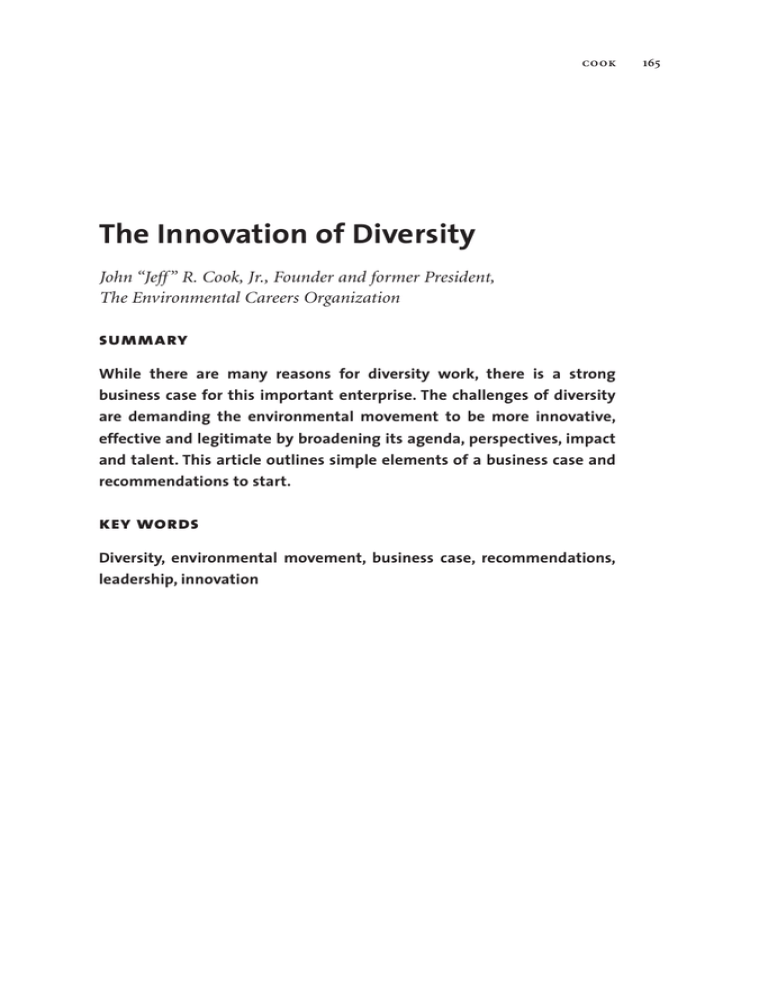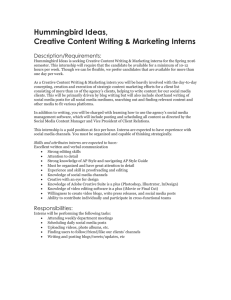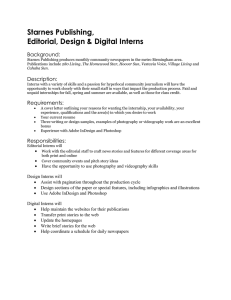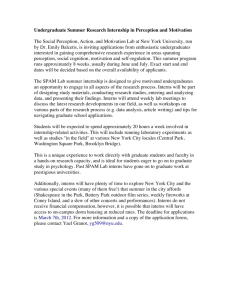The Innovation of Diversity summary The Environmental Careers Organization
advertisement

cook The Innovation of Diversity John “Jeff ” R. Cook, Jr., Founder and former President, The Environmental Careers Organization summary While there are many reasons for diversity work, there is a strong business case for this important enterprise. The challenges of diversity are demanding the environmental movement to be more innovative, effective and legitimate by broadening its agenda, perspectives, impact and talent. This article outlines simple elements of a business case and recommendations to start. key words Diversity, environmental movement, business case, recommendations, leadership, innovation 165 166 diversity and the future of the u.s. environmental movement In the late 1980s, the Environmental Careers Organization (ECO) was asked by several of its sponsoring agencies, companies, organizations and foundations to address the under-representation of people of color in its intern programs and the environmental movement in general. Little did we know, this request would start us on a journey of learning – of mistakes and adjustments, of meeting new people and leaders, and of improving our mission and delivery of services. This journey continues to this day. So, why did a small “careers” organization decide to commit to this diversity work when so many others were not? Yes, it was the “right” thing to do although there were high risks and limited rewards. Yes, some of our key customers were asking us to explore the work, but even more were asking why we were investing our energies in this way. One national foundation even told us that diversity was no longer a problem because they had just finished a five-year grant cycle addressing the issue! The answer to this question is simple. With the benefit of hindsight that an article of this kind permits, we can confidently argue that our diversity work makes us a better organization. We function better because we are more open to new ideas and new ways to serve our mission and our constituents. We have a new supply of creative and energetic talent for our internships, staff and board. We have accessibility to new agencies, companies and organizations to place our interns. We think better because we have different points of view in our program management and development exercises. With the benefit of hindsight that an article of this kind permits, we can confidently argue that our diversity work makes us a better organization. We function better because we are more open to new ideas and new ways to serve our mission and our constituents. We have a new supply of creative and energetic talent for our internships, staff and board. We have accessibility to new agencies, companies and organizations to place our interns. We think better because we have different points of view in our program management and development exercises. cook We have struggled with this work and we still are. That struggle makes us a better organization because of the results, the lessons learned and the pride of accomplishment. It prepares us to struggle, learn and achieve in others areas of our mission work. Industry has long understood the value of diversity. Even Fortune Magazine includes “diversity programs” as one of the criteria its ranking of 100 Best Companies to Work For. Quite simply, while there are many reasons for diversity work, there is a strong organizational or business case for this work. I want to outline the elements of the organizational case for diversity and include some recommendations for organizations interesting in pursuing diversity initiatives of their own. Let me start by defining two fundamental tenets of diversity work: 1. Diversity is a natural law – monocultures tend not to survive, as they are vulnerable to disease, decay and disappearance. Multi-cultures thrive because there is strength in many species that are competitive and compatible with each other. 2. Nature is what brings us together. The environment is the commonality of humans. It is illustrated in religions, poetry, humanities and the arts. Each of these fields reveals a reverence of nature that transcends boundaries, tribes, stories and thinking. This reverence for nature is what unites us as a species rather than divides us. If we are to be an effective social movement, we need to unite under this commonality. We need to bring new energy, perspective and commitment to this critical work. As these tenets suggest, in order to survive and adapt to changing conditions, environmental organizations should both maximize their diversity and focus on building common ground between diverse members. In the case of the environmental movement, the need for adaptation is even more evident than many other sectors. Right now, many are arguing that the relevance and the public mandate of the environmental movement is slipping as its issues are being “spun” and framed as elitist, extremist and obstructionist. In the last presidential election, current and emerging environmental issues did not play a role in the election outcome largely because both candidates were counseled that these issues were not important to the 167 168 diversity and the future of the u.s. environmental movement general voter. The essay The Death of Environmentalism and Michael Crichton’s book State of Fear struck a responsive chord with the public. The environmental movement needs new energy, perspectives and re-vitalization. The first Earth Day was a wonderful example of an effective coalition of different parts of the community and political landscape. Leaders and people from all across the economy, community and country joined. Churches, unions, organizations, colleges and universities were represented. All kinds of movements joined forces: peace, environmental, women’s lib, civil rights, economic justice and more. All political parties were involved. We are a long way from that original coalition and vision. We need to return to that broad base of energy and commitment. In fact, the strength of this coalition was its diversity, and we now need to re-capture that expansive source of support and involvement. Broadening the environmental agenda to include people of color and their issues will add to our public mandate and legitimacy. The environmental field needs to innovate and diversity is the agent for innovation. “. . . while invention is a flower, innovation is a weed. We innovators have to be willing to be viewed as weeds by old boy networks. Innovation, in my experience, is not done by old boy networks, but by people, sometimes collaborating and mostly competing and annoying; teams of women and men – scientists, engineers, entrepreneurs, and of course, venture capitalists . . .” Bob Metcalfe, general partner of Polaris Venture Partners This quote points to the challenges and the opportunities of the innovation of diversity. As much as environmental values are challenging our larger society to be more efficient and less damaging to our natural resource systems, diversity is demanding the environmental movement to be more effective by broadening its agenda, perspectives, impact and talent. The “old boy network” is the hurdle to the innovation of diversity. The old boy network can indeed be a group of elites who do not want things to change. Or it can be maintaining the status quo and well worn practices “We do it that way because we have always done it that way.” Regardless, the leaders and strategies for diversity need to be cook annoying to stimulate the innovation and overcome the reluctance to change the old boy network of people and status quo. The “old boy network” is the hurdle to the innovation of diversity. Weeds might be a good metaphor for our diversity work. Weeds are very efficient and innovative in making “progress” by taking ground. And one person’s weed is another person’s flower. Diversity advocates and practitioners need to stimulate innovation and change to capitalize on the opportunities before us. In addition to being critical to the success of the environmental movement, diversity is important to organizations for practical reasons as well. For example, in looking at future trends in wealth and philanthropy, diversity is playing an increasing role. The green movement has grown up on the baby boomers who are aging. As the latest census figures show, the U.S. population is becoming more diverse. Minorities are becoming the majority. How will the current “green” donor be replaced and who will replace them? In those changes, there are new opportunities and challenges for fund-raising, with diversity playing a more prominent role than in the past. It is logical to anticipate that more diverse donors will prefer to support more diverse organizations. How will the current “green” donor be replaced and who will replace them? In those changes, there are new opportunities and challenges for fund-raising, with diversity playing a more prominent role than in the past. It is logical to anticipate that more diverse donors will prefer to support more diverse organizations. In this case, it will behoove organizations seeking funding to employ a diverse staff. As the supply of staff tightens as the large generation of Baby Boomers retires, effective organizations will have 169 170 diversity and the future of the u.s. environmental movement the opportunity to recruit from a diverse supply of talent to fill their staff positions. They will also have to be a lot more competitive and creative in the recruitment and retention of staff. But in order to recruit and retain diverse staff, an organization has to offer mission, programs and services that appeal to different types of people. Increasingly, young staff, diverse or not, want to see diversity programs inside organizations and through its program services and mission. It is a question of being up to date, current and legitimate. In the last twenty years, Environmental Careers Organization has placed close to 3,000 diverse interns. We have researched and written three publications on diversity in the environmental field. We have held national conferences and diversity round tables. We have raised and distributed hundreds of thousands dollars to place interns in low income communities and communities of color. ECO staff has visited hundreds of minority academic institutions, career fairs and conferences to promote the wonders of environmental careers. As a result of these efforts, many diverse ECO alumni now hold management and leadership positions across the environmental sector. In fact, today, over 35 percent of our annual placements of interns are students of color; 38 percent of our staff is from diverse backgrounds and 50 percent of our board are people of color. Compared with figures of less than 8 percent for our board, staff and interns in 1988, these figures reflect a vast increase in the diversity of ECO over the last two decades. As a result of these efforts, many diverse ECO alumni now hold management and leadership positions across the environmental sector. In fact, today, over 35 percent of our annual placements of interns are students of color; 38 percent of our staff is from diverse backgrounds and 50 percent of our board are people of color. Compared with figures of less than 8 percent for our board, staff and interns in 1988, these figures reflect a vast increase in the diversity of ECO over the last two decades. cook In reporting these successes, we do not wish to imply that our journey to diversity is complete. However, we do believe that, in traveling this path, we have learned some important lessons that we are excited to share. The following recommendations reflect these lessons: Recommendation #1: Diversity is a leadership issue and should be one of the top five issues for the organization. It needs to be managed for results. Leadership involves the board, executive management, staff, funders and clients. Recommendation #2: Like every leadership issue, diversity needs a plan and accountability. This includes a plan with goals, objectives that can be measured, and a timetable that stays on track. The results of the plan and schedule should be reported regularly to the board. This plan must be part of recognition and compensation of management and staff. Recommendation #3: The diversity plan and accountability for it should be present throughout the organization, its departments, and functions. It has to become part of the whole organization. It has to be the responsibility of everyone, and everyone has to be accountable. Recommendation #4: Diversity should be seen as a commitment and a learning journey. Success in the pursuit of diversity takes a long time, and, in fact, diversity may never be “achieved.” It is only possible to get closer. Recommendation #5: Begin, listen and learn. In the late 1980s, we developed a diversity plan through the work on an ECO intern. As part of this plan, we met and talked with leaders from many sectors, including organizations serving communities of color and environmental justice organizations. We listened to what they had to say and how we could help them. Then we responded in a way that conformed to our mission – by placing interns with them to work on their issues and priorities. And this process continues today. Overall, the key to our success was that we acted, we learned from our actions and mistakes and we acted again all in concert with these 171 172 diversity and the future of the u.s. environmental movement leaders, their communities and their work. And in doing so, we became better people, better managers, better leaders, and a better organization. about the author John “Jeff” R. Cook, Jr. is the founder and former president of The Environmental Careers Organization (ECO), which for thirty-five years helped create the next generation of environmental professionals, managers and leaders. It accomplished this through intern programs, web sites, books, publications and on campus events. Mr. Cook is married to Brooke Chamberlain Cook, has two sons (Ransom and William) and a stepdaughter (Sarah Rosa), and lives in the Boston area. Jeff Cook 617.504.7402 jrcookjr@gmail.com


